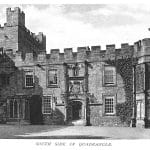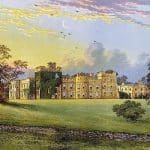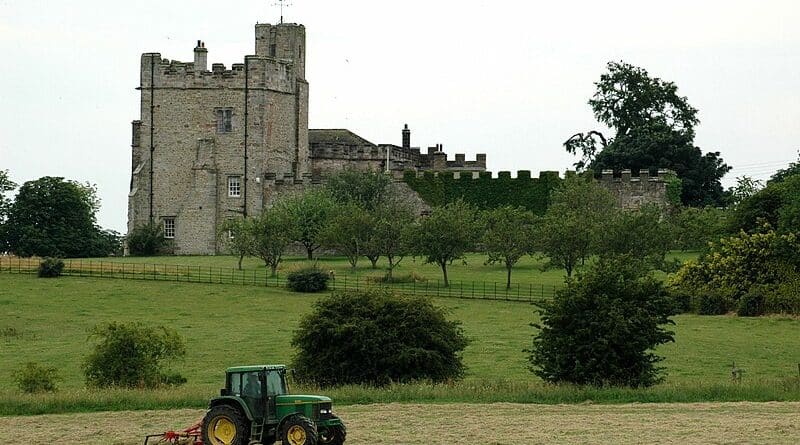Hornby Castle in North Yorkshire
Hornby Castle, North Yorkshire has a history littered with possibles and maybes rather than documented facts. The site has been subject to extensive archaeological study which helps to firm up theories but they are likelies rather than definates on some aspects. What we do know for certain is that there have been several fortified sites at Hornby which may or may not be on the same site. These range from moated hunting lodges of the 12th century, through a castle known to have had a chapel during the Wars of the Roses, to a large manor house styled as a castle that was built in the 16th century.

By Charles Latham (1847-1912) – From In English Homes [1907]. Public Domain, via wikimedia
12th century moated hunting lodges at Hornby
The Manor of Hornby was held by the Dukes of Brittany in the 12th century. It is known from documentary records dated to 1115 and 1175 that they held a moated hunting lodge at Hornby. Evidence from the archaeological project at Hornby strongly suggests that this lodge was at the site of the current Hornby Castle. Several trenches have found materials dating to the 12th century. This includes suggests as to the existence of a chapel in the 12th century and some of the finds make the link to George Plantagenet, Duke of Brittany [and third son of King Henry II] clear as well. These finds are noted at various places within the fieldwork reports here.
14th and 15th Century development of Hornby Castle, Richmondshire
Parts of the Castle are documented as having been built in the 14th century. These include St Quintin’s Tower which was constructed in the late 14th century. This tower later was incorporated either in part of whole into 18th century refurbishments and the development of ranges. However, these were demolished in 1927, though have been eamined by archaeologists.
The archaeology of the site suggests that parts of the site may have been developed in the early 14th century by Sir John Neville of Redbourne. These finds include water pipes made of elm, along with a bridge and adjoining postern gate. There is also evidence of the moat being worked on in the early 14th century, as a chamber was built into it which dates to the period.
The 14/15th finds at the site show a degree of sophistication that the report notes was usually associated with those families close to the crown. In simple terms, the site seems to have been quite luxiourious and suitable for accomodating the highest ranked people in the land.
In the 14th and 15th centuries Hornby Castle was held on the most part by the St. Quentins family, then the Conyers family. Sir John Conyers is known to have developed the site in the mid 15th century. Hornby had ties to the Neville Earls of Westmorland and Raby Castle throughout the era, which was cemented in 1499 through the marriage of Sir William Conyers to Anne Neville, a daughter of the 3rd Earl of Westmorland.

Hornby Castle Links
British History Online – Victoria County History entry for Hornby near Bedale.
Historic England – Official listing of Horby Castle in Bedale, North Yorkshire
Gatehouse Gazetteer – Hornby Castle, Richmondshire
Parks and Gardens – history of the Castle, Parks, and Gardens
Castle Studies Trust – Hornby Castle Project
The Architectural and Archaeological Society of Durham and Northumberland. Detailed account of excavations carried out at Hornby Castle.
Featured Image
By Stephen George-Powell – via wikimedia. CC BY 2.0, Originally posted here.
